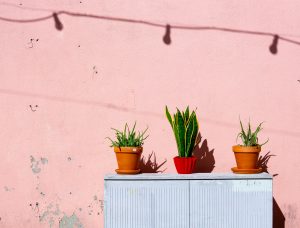A beautifully landscaped garden is an asset to any property. It provides curb appeal for your property and increases its value. If you know how to layer landscaping and do it right, you will end up with a garden that looks effortlessly beautiful, with a balance of trees and flowers and an aesthetically pleasing effect.
Start by Preparing Your Property for New Landscaping
If you are new to landscaping, the task of designing your garden from scratch may seem overwhelming. The best way to overcome the overwhelm is to think of your garden as another room in your house. Consider the shape of the area and how you intend to use the garden. Study the sun patterns. Then, sketch a plan on paper. It will help you visualize the entire project and help you plan your work.
If you have any existing plants in the space, think about whether you will keep them or need to move them to a more convenient spot. If you have any existing trees, you will need to decide whether you want to keep them or whether they should be removed. If the trees are big, you may need a tree removal services company to do the job.
Consult the Right Professionals
When starting your landscaping design, start with a sketch of what you want the finished garden to look like. It will give you a better idea of what must be done to get that beautiful layered landscaping look. If you get stuck and feel that your ideas need refinement, consider hiring landscape architects to help you get your ideas out of your head and make your dream garden a reality.
Sometimes, hiring the right professionals will help you save time and money by saving you from making mistakes in your design.
The most common mistake new garden landscapers make is putting garden features like patios, fire pits, and swimming pools without considering the sun and wind patterns in the garden space. Putting a patio in a spot that gets the full afternoon sun may be great for winter months, but in the middle of summer, your patio may become unpleasantly hot, baked by the scorching afternoon sun. Also, if you put a firepit in an area exposed to prevailing winds, it may be difficult to keep the fire going on windy evenings.
The same goes for placing a swimming pool. You want to place your pool in a spot away from trees that lose their leaves over winter. Otherwise, you will spend all your time skimming leaves out of the water.

Take Care of Grading and Slope Issues
Grading means two things. One is creating a desirable slope in your garden to ensure the ground slopes away from the house. The other is to ensure the ground is level by filling in all holes and creating an even surface. A level garden area is beautiful and more functional, especially for family outdoor games.
A slight sloping gradient away from the house is also functional. It will keep any natural moisture, like rain or melting snow, away from the house and the basement. Water always drains and collects in the lowest part of the property, so ensuring that the ground slopes towards the property lines where you have border plants is efficient because it will ensure that those areas receive maximum water and save on watering. If your ground slopes towards the house, you may end up with damp walls or, in the worst case, with a flooded basement.
Not every garden is flat; sometimes, the garden is on a hill, and you have a natural slope to contend with. If you want to build a patio, you may have to figure out how to layer your landscaping by creating a level patio area using a retaining wall. You can also use this technique to build special flower and plant beds. Beds that are supported by a retaining wall will keep the soil in. Hiring an expert to do the job, like a retaining walls contractor, is the most effective way to get it done. However, if you are an experienced garden landscaper, you may want to attempt to build the retaining walls for planting by yourself.
Install Hardscaping Features
Hardscaping transforms your garden from an everyday place where plants grow, and you don’t visit too often to an oasis of comfort where you can gather with your family and entertain guests. It is a place where you can relax, and it provides an extension of your home’s living areas.
Hardscaping creates areas for sitting, relaxing, and enjoying your garden. It includes patios, firepits, swimming pools, pergolas and retaining walls. Again, depending on your personal skill set, you can decide where they go and build these structures yourself or hire professional hardscape contractors to show you how to layer landscaping effectively.

Plant New Trees in the Right Places
Trees don’t only look beautiful but are also functional parts of the garden if planted right. Trees add value to your home, and you will never get tired of looking at them because they continually grow and change.
You can plant large trees as focal points in your garden or opt for small trees with ornamental leaves or berries that will add depth and different levels to your garden.
You can use trees as a screen to protect you from prevailing wind patterns in your garden. A permanent windbreaker made from trees will blend in without looking awkward and create a secluded area where you can enjoy being in your garden without being blown away by the wind.
For more advice on how and where to plant trees in your garden, contact your local tree company to help you make the final decision.
Install Lighting and Electrical Features in Advance
Lighting in your garden is more than just a pretty feature. It is needed for safety, too. Well-lit pathways, entrance points, and lawn areas prevent anyone from accidentally twisting their ankle when walking over uneven ground in the dark.
Take lighting needs into consideration when determining how to layer landscaping in your garden. Various landscape lighting installations and cabling should be laid down and secured before you start preparing your planting areas.
There are various types of lighting available on the market, so you can choose whether you want lights to be mounted on garden walls, in between shrubs, or install flood lights to illuminate the whole area in the garden. Flood lights are especially suitable for large lawn areas if you want to play sports and games at night.
Whichever type of lighting you choose and how you install it, be eco-conscious and make use of solar power lights and low-energy lighting whenever possible. You will not only save on the electricity bill but also help the environment.

Don’t Forget About Your Lawn
When you think about a garden, first you think about plants, followed closely by grass areas. Beautiful lawns make your garden feel spacious and make wonderful play areas for your children and pets.
Lawns will be a part of the lowest layer in your garden. It is a place where you can host picnics, play games, exercise your pup, and even lie still and admire small creatures that made their home on your turf.
Getting a beautiful lawn doesn’t need to be a chore or take a long time. You can call one of your local companies who handle grass sod installation, and you will have a beautiful lawn ready by teatime.
Plan for Maintenance
Once you landscape your garden, you must maintain it to keep it in good shape. It doesn’t need to take much time if you planned and layered your landscaping correctly. Small tricks of the trade will ensure the garden layout is efficient, like planting lawns with straight edges next to paved areas and pathways to make mowing easier.
Not all available planting areas must be planted with flowers and shrubs. Planting a mixture of grasses and wildflowers indigenous to your climate and area will ensure you can leave them to grow without worrying about weeding and trimming.
Your lawn may need feeding and fertilizing annually, and you can delegate this task to lawn treatment companies that will take care of it for you.

Train Trees as They Grow
A well-landscaped garden will have trees of various heights to provide the most pleasing aesthetic.
Planting trees can add additional layers and interest to your garden. How to layer landscaping? Using trees as focal points in flower beds or adding interest to your garden with unusual colours or shapes of leaves is a great idea. You can purchase young trees and train them to grow into any shape you want (within reason). If you purchase a young tree, you can prune and shape it as it grows so it grows into a well-balanced specimen that will look as attractive as it is useful. If you have never trained a tree before, look up experts called arborists, otherwise known as tree surgeons, who can help and advise you on how to proceed with your tree training.
Keep Weeds Out and Plant Annuals Appropriately
One of the downsides of having a garden is the need for regular weeding and maintenance of your plants. To do that effectively, you will need to invest in garden equipment to help you get the job done.
Here is a list of basic tools you will need to landscape and maintain your garden:
- Gloves – You will need those to protect your hands from the soil and thorny foliage.
- Spade – A good spade is worth its weight in gold. Once you find one that fits into your hands perfectly, it will make the work easy when you need to dig holes for planting, move mounds of dirt from one place to another, edge the pathways, and lift sods.
- Trowell – For planting flowers and other plants all around your garden. It can be especially useful for taking out weeds. You can also use it to put plants in containers. Best choose one with a handle that fits your hand comfortably.
- Hoe – There is no better tool for weeding and loosening the soil around the plants as they grow than a hoe. Find one made of sturdy steel that will last you a lifetime. Weeding hoes have an open square head and are pushed back and forth beneath the soil to cut down growth. If you have perennial flower beds, choose a hoe with a narrower head to prepare your flower beds and cut down weeds.
- Rake – Any debris, leaves, and grass cuttings need to be gathered by a trusty rake before being taken away. They come in many sizes. Some are even adjustable, so you set them to a narrower width to use in narrow spaces or set them wide to rake up a pile of leaves.
- Wheelbarrow – there is always something that needs to be moved around in a garden. Your wheelbarrow will come in handy for all garden jobs. You can use it for anything from spreading fertilizer or hauling away mountains of leaves.
- Lawnmower – Your beautifully manicured lawns will be the envy of the whole neighbourhood. Regular trimming of the grass promotes healthy growth. It’s a piece of gardening equipment that is a must-have in any garden.
- Pruning shears – To get the perfect layers of foliage and flowers, you will need to trim plants to achieve that perfect shape. You will probably need more than one pair of those in different lengths to reach all places.
Attempting to design a perfect garden for the first time can be intimidating. It is a big task with many parts that need to work together. You need to start with a good plan and a sketch of what you want your garden to look like. Prepare the ground and map out where all the hardscaping features should go. After that, install lighting, lawn, and plant your flowers, shrubs, and trees. Using our advice, hopefully, has taken some of your fear away. We wish you all the best and hope you will have a beautiful garden in no time.




